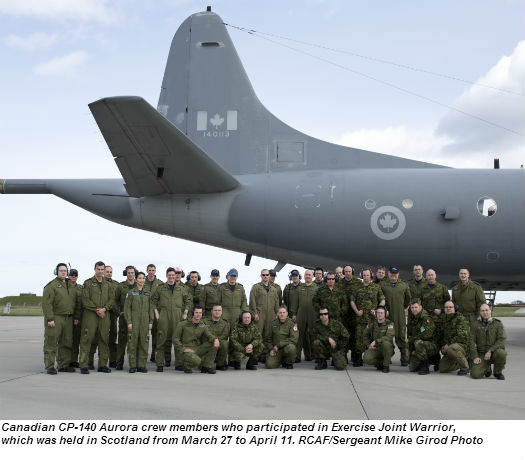RCAF Press Release | May 7, 2014
Estimated reading time 3 minutes, 28 seconds.
Crews from two CP-140 Aurora long-range patrol squadrons recently returned from a major international maritime patrol exercise held in Scotland.
The crews came from 405 Long Range Patrol Squadron, located at 14 Wing Greenwood, Nova Scotia, and 407 Long Range Patrol Squadron, located at 19 Wing Comox, British Columbia.
Exercise Joint Warrior, which is held twice a year, is planned by the Royal Navy and the Royal Air Force. According to the Royal Navy, 13,584 personnel – as well as 33 ships three submarines, 48 fixed-wing aircraft and 40 rotary wing aircraft – took part in the spring 2014 edition of the exercise, held from March 27 to April 11, 2014, at RAF Lossiemouth.
Personnel from 405 and 407 Squadrons joined air force crews from Norway (flying the P-3 Orion), New Zealand (flying the P-3K Orion), France (flying the Atlantique 2) and the United States (flying the P-3 Orion and P-8 Poseidon).
The combined Canadian detachment, flying the CP-140 and CP-140M Aurora long-range patrol aircraft, comprised the high readiness crews from the east and west coasts to confirm the Long-Range Patrol Air Expeditionary Unit capability.
The exercise was based on a geo-political scenario that imagined a hostile nation that had invaded the territory of an allied nation in the hopes of seizing valuable natural resources such as offshore oil deposits.
During the exercise, Canadian assets were tasked by both the “allied” and “enemy” forces. The crews maximized their time on anti-submarine warfare training and participated in anti-surface warfare and overland missions.
Due in large part to the professionalism of the crews from 405 and 407 Squadrons, and logistical support from 14 Wing, the Canadian team was able to self-deploy and sustain their operations over 14 sorties during the fictitious war-time scenario. Considering that the CP-140 and CP-140M (the aircraft that have gone through the Block III Aurora upgrade) contain different tactical equipment and software, the detachment’s ability to achieve mission success throughout the exercise without relying on external support or strategic airlift speaks volumes for the efforts of the maintainers on the ground in Scotland.
The deployment’s headquarters staff remarked at the cooperation between the air and ground crews of the deployed units to accomplish the mission. For instance, when a tail had to be swapped due to a radar malfunction, all personnel worked quickly to get the job done. This would have been difficult when dealing with identical airplanes, but it was especially challenging due to the differences between the CP-140 and CP-140M and the individual qualifications of the aircrew and technicians.
Overall, the exercise was a great experience for everyone involved. The crew training and the exchange of information with our international colleagues will go a long way to preparing the Air Expeditionary Unit crews from 405 and 407 Squadrons for further success in real world operations.

